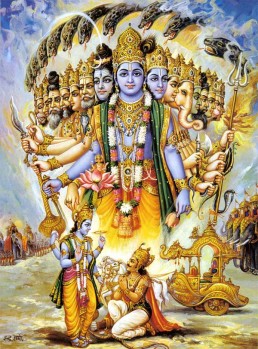Swami Chinmayananda
Swami Chinmayananda Commentary
If gold is the essential stuff in all the ornaments, every ornament in the world must be available in the total gold. To see the gold in the ornaments is relatively easy, it being a PHYSICAL PERCEPTION. But to detect the presence of all ornaments of different shapes and colours in the total gold is comparatively difficult, inasmuch as it is the VISION OF THE INTELLECT.
Keeping this idea in mind, when you read the opening lines of the Lord’s words, it becomes strikingly significant. “BEHOLD, BY HUNDREDS AND THOUSANDS, MY DIFFERENT FORMS CELESTIAL, VARIED IN COLOURS AND SHAPES.” It was not necessary for Krishna to change His form to that of the Cosmic-Man; all that Arjuna had to do was to BEHOLD THE FORM right in front of him. But, unfortunately, the instrument-of-perception was not tuned up for the object of his investigation, and therefore, Arjuna could not perceive that which was already in Krishna.
That which is lying beyond the focal length of a telescope, cannot be viewed by the observer even though the object may be present in line with the axis of the instrument. In order to bring the farther object within the span of vision, the observer will have to make the required adjustments in the telescope. Similarly, Krishna did not TRANSFORM Himself into His Cosmic-Form, but He only helped Arjuna to make the necessary inward adjustments so that he could perceive what was there evidently in Krishna. Naturally, the Lord says, “BEHOLD.” The total world of perceivable beings of all shapes and colours is indicated in the enumeration made by the Lord in the stanza.
WHAT ARE THOSE?
Adi Sankara Commentary
O son of Prtha, pasya, behold; me, My; rupani, forms; satasah, in (their) hundreds; atha, and; sahasrasah, in thousands, i.e. in large numbers. And they are nana-vidhani, of different kinds; divyani, celestial, supernatural; and nana-varna-akrtini, of various colours and shapes-forms which have different (nana) colours (varna) such as blue, yellow, etc. as also (different) shapes (akrtayah), having their parts differently arranged.
The Bhagavad Gita with the commentary of Sri Sankaracharya – Translated by Alladi Mahadeva Sastry
Holy Geeta – Commentary by Swami Chinmayananda
The Bhagavad Gita by Eknath Easwaran – Best selling translation of the Bhagavad Gita
The Bhagavad Gita – Translation and Commentary by Swami Sivananda
Bhagavad Gita – Translation and Commentary by Bhaktivedanta Swami Prabupadha
Srimad Bhagavad Gita Chapter 11 – Verse 5 – 11.5 pasya me partha – All Bhagavad Gita (Geeta) Verses in Sanskrit, English, Transliteration, Word Meaning, Translation, Audio, Shankara Bhashya, Adi Sankaracharya Commentary and Links to Videos by Swami Chinmayananda and others – 11-5

